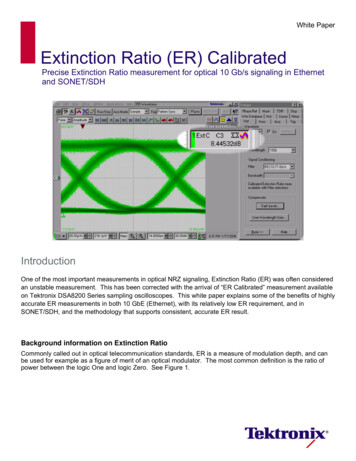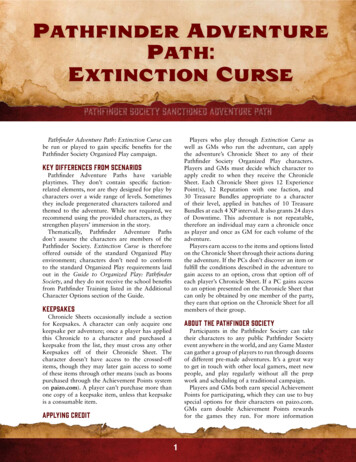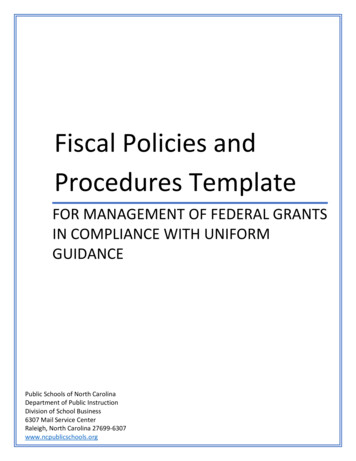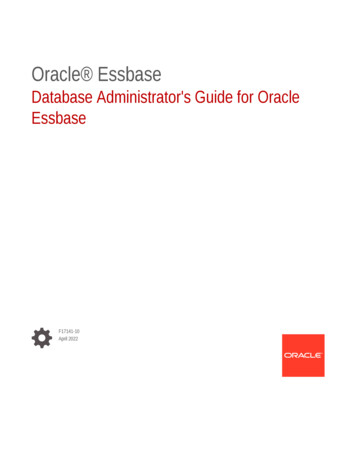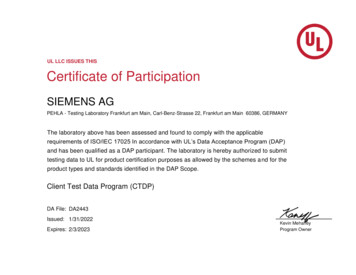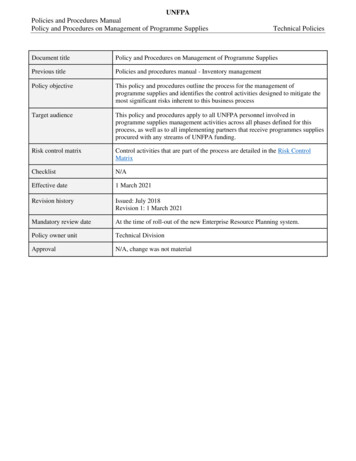
Transcription
UNDERSTANDING AND USINGEXTINCTION PROCEDURESChrista Homlitas, M.S., BCBA, COBABoard Certified Behavior AnalystCertified Ohio Behavior AnalystLicensed Behavior Analyst (MA)Coordinator, Remote & International ProgramKnapp Center for Childhood DevelopmentDr. Julie Knapp, Ph.D, BCBA-D, COBAPediatric NeuropsychologistBoard Certified Behavior Analyst-DoctorateCertified Ohio Behavior AnalystExecutive DirectorKnapp Center for Childhood Development
GOALS OF TRAINING Understand the definition of extinction Understand how to implement extinction based on behavior function Understand the effect of extinction on rate of behavior Understand generalization and maintenance as it relates to behavior reduction
WHAT IS EXTINCTION? Technical definition: procedure in which reinforcement is no longer provided for apreviously reinforced response In order to effectively discontinue the reinforcing consequence we must firstcorrectly identify the function of the behavior
REVIEW OF FUNCTIONS OF BEHAVIORFUNCTIONDEFINITIONEscapeAn individual engages in behavior so they can escape or avoid something they find aversive. Forexample, an individual may engage in aggression to stop a teacher or therapist from working with them.AttentionAn individual engages in behavior in order to gain some form of social attention or a reaction fromother people. An individual may engage in behavior to get other people to look at them, laugh at them,play with them or even scold them. Negative attention is still attention!TangibleAn individual engages in behavior so they can gain access to a tangible item or desired activity. Forexample, the individual may scream and shout until their caregiver buys them or provides them a newtoy.AutomaticAn individual engages in a behavior simply because they enjoy the behavior. The behavior does not haveanything to do with external reinforcement from others. For example, an individual may rock back andforth because it is enjoyable for them.
EFFECT OF EXTINCTION ON BEHAVIOR When extinction is implemented correctly and consistently a gradual reduction in behavior is observed over time. Extinction burst: initial increase in behavior (can be above baseline levels) before a decrease in behavior is observedwhen extinction is implemented Behavior “gets worse” before it “gets better” Important to remain consistent with implementation if an extinction burst occurs. Team should plan for this possibility.
EXTINCTION BURSTS Extinction bursts usually suggest that the reinforcer(s) maintaining the problembehavior was successfully identified, indicating that there is a good chance of aneffective intervention
EXTINCTION: EFFECT ON BEHAVIOR
EXTINCTION EFFECTS: SPONTANEOUS RECOVERY Spontaneous Recovery The behavior that diminished during the extinction process recurs even thoughthe behavior does not produce reinforcement Short-lived and limited if the extinction procedure remains in effect.
EXTINCTION EFFECTS
EXTINCTION EFFECTS
EXTINCTION Advantage: does not require aversive procedures Effectiveness depends on: Correct identification of function Consistent application Extinction does not prevent occurrences of problem behavior Environment is changed so that problem behavior does notproduce reinforcing consequences anymore
MISUSE OF EXTINCTION Often extinction is equated with ignoring a behavior This is an example of extinction only under what circumstance? Extinction is not the same as ignoring problem behavior, rather it differs according tothe function of the behavior, or what reinforcer the problem behavior is producing.
MISUSE OF EXTINCTION Using “extinction” to refer to any decrease in behavior Some use the term extinction when referring to any decreaseresponse performance, regardless of what produced thebehavior change. Labeling any reduction in behavior that reaches a zero rate ofoccurrence as extinction is a common misuse of the term.
HOW TO IMPLEMENT EXTINCTION Attention Extinction Implemented for problem behavior maintained by positive reinforcement:attention Ignore the problem behavior This means no eye contact, no verbal statements, no physical contact with theclient – NOT even scolding or “negative” attention! Can be difficult to implement If the individual is receiving inadvertent attention (sometimes this means ournonverbal body language), extinction procedure will be ineffective
HOW TO IMPLEMENT EXTINCTION Escape Extinction Implemented for behavior maintained by negative reinforcement: escape fromdemands DO NOT allow the problem behavior to produce delay or terminationof task Continue to represent demand or instructions and prompt follow through Can also be difficult to implement, especially if you cannot physically ensure followthrough with a task demand, if this is the case you may want to opt for analternative intervention
HOW TO IMPLEMENT EXTINCTION Extinction: Access to Tangible Items Implemented when behavior is maintained by positive reinforcement in the formof access to desired items/activities DO NOT allow the problem behavior to produce access to the desireditem Item/activity is withheld contingent upon problem behavior Appropriate behavior can yield access to desired items –such as using acommunicative response to request (i.e. verbal, PECS, sign, etc.)
HOW TO IMPLEMENT EXTINCTION Sensory Extinction Implemented for behaviors maintained by automatic reinforcement Mask or remove the sensory consequence for the behavior Can be difficult to determine the specific sensory consequence May be impossible to prevent or eliminate
OVERVIEW OF EXTINCTION PROCEDURESFunction of behaviorExtinction ProcedureAttention (positive reinforcement)Ignore the behavior (no eye contact, verbal statements or reprimands, no physicalcontact with the individual)Escape (negative reinforcement)Do not allow the problem behavior to produce the termination of a task/activityOR delay the completion of the demand given. Continue to represent the demandor instruction and prompt completion or follow through.Tangible (positive reinforcement)Do not allow the problem behavior to produce access to a desired item/activity.Automatic reinforcementMask or remove the sensory consequence for the behavior. Sensory extinction canbe more difficult to implement as the specific reinforcing consequence might bedifficult to determine or impossible to eliminate. For example, if an individual isscratching their body (due to the tactile consequence it produces) we can removethe sensory consequence by putting a glove on the individual’s hand and thengradually fading the use of the glove.
VARIABLES TO CONSIDER WHEN IMPLEMENTING EXTINCTION Continuous and intermittent reinforcement Continuous reinforcement: each response is reinforced Reduce at a faster rate when behavior is put on extinction Intermittent reinforcement: each response is not reinforced, onlysome responses are More resistant to extinction Greater number of trials needed to come in contact withcontingency
VARIABLES TO CONSIDER WHEN IMPLEMENTING EXTINCTION History of Reinforcement Behavior has produced the reinforcing consequence for a significant duration oftime Behavior will be more resistant to extinction than behaviors with a short historyof reinforcement
VARIABLES TO CONSIDER WHEN IMPLEMENTING EXTINCTION Motivation to respond Behavior might be more resistant to extinction if the motivation to engage in the behavior is high For example, problem behavior previously produced access to food. Child is very hungry (EO), problem behaviormay be more resistant to extinction under these conditions.
VARIABLES TO CONSIDER WHEN IMPLEMENTING EXTINCTION Extinction produced aggression When one behavior is placed on extinction, you might observe other non-targeted problem behaviors Extinction can generate novel responding Emotional behaviors, such as aggression, can occur when a target behavior is placed on extinction When implementing extinction it is wise to teach an appropriate way to gain the same reinforcer Extinction is rarely used alone or as a sole intervention because it does not teach an alternative response
PLANNING FOR EXTINCTION PRODUCED AGGRESSION Behaviors that occurred infrequently in the past willsometimes become prominent during extinction byreplacing the problem behaviors. Frequently, these sideeffect replacement behaviors are aggressive (Lerman etal., 1999)
VARIABLES TO CONSIDER WHEN IMPLEMENTING EXTINCTION Number of Extinction Trials Increasing the Number of Extinction Trials An extinction trial occurs each time the behavior does not producereinforcement. Whenever possible, applied behavior analysts should increase the number ofextinction trials for the problem behaviors.
UNINTENTIONAL EXTINCTION OF DESIRED BEHAVIOR It is important to consider the effects of extinction on desired behaviors as well Let’s look at an example. Our student was receiving reinforcement each time they made eye contact with the teacher in the form of an edible item.The teacher was thrilled that this response was increasing. Once the child was looking at least 80% of conducted trials, theteacher eliminated the use of the edible. She was disappointed to find that over the next week, eye contact decreased again. Highlights the importance of fading/intermittent reinforcement
BEHAVIOR HIERARCHYLevel 1Level 2Level 3Level 4 Differential Reinforcement Procedures DRA, DRO, DRI, DRL Extinction Negative Punishment Procedures Time-out, response cost Postive Punishment Overcorrection, introduction of aversives
Certified Ohio Behavior Analyst Executive Director Knapp Center for Childhood Development Christa Homlitas, M.S., BCBA, COBA Board Certified Behavior Analyst Certified Ohio Behavior Analyst Licensed Behavior Analyst (MA) Coordinator, Remote & International Program
